Pyramid Hill Historical Plaques Walk

The Pyramid Hill and District Historical Society have installed plaques at historic sites in the Pyramid Hill township. You are invited to stroll the streets and learn about the township's rich history.
Pyramid Hill Historical Plaques Walk Map
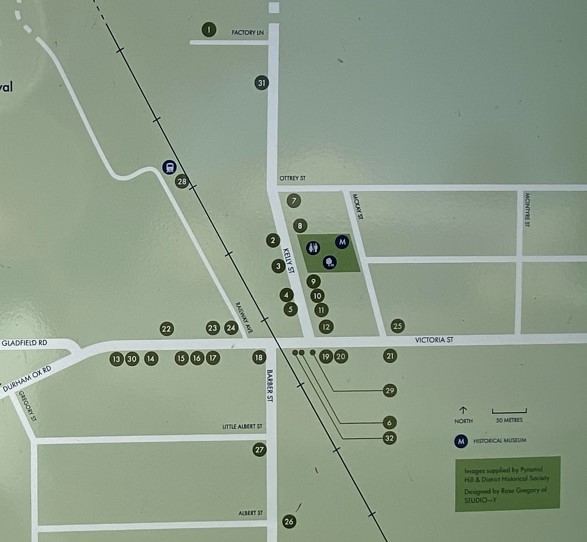
1. Butter Factory
2. Chemist Shop
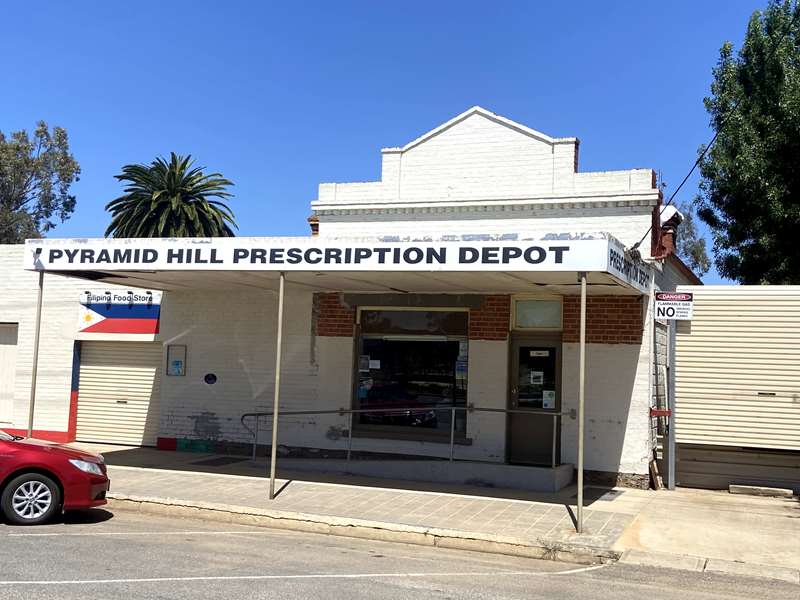
The township has been served by chemists since 1893. The first chemist, S M Dalton, was followed by:
1897 A E Taylor, 1911 W R Weir, 1920 H W de Gruchy, 1922 C R Barrett, 1935 R O Phillips and 1981 A Cozens.
Over the years, as well as compounding medications, the chemists sold toiletries and assorted giftware, including cameras, and developed photographic films. In 1984 this chemist shop and residence became a depot for the Cohuna pharmacy.
3. Cafe
A number of cafe businesses were conducted on this site. Some of the owners to run cafes here were Rangott, Nashcke, Miller and Sotos. The final cafe owner was Paddy Hayes. The cafe building was demolished in the late 1960s. The Lions Park was opened in the 1970s.
4. 7 Kelly Street
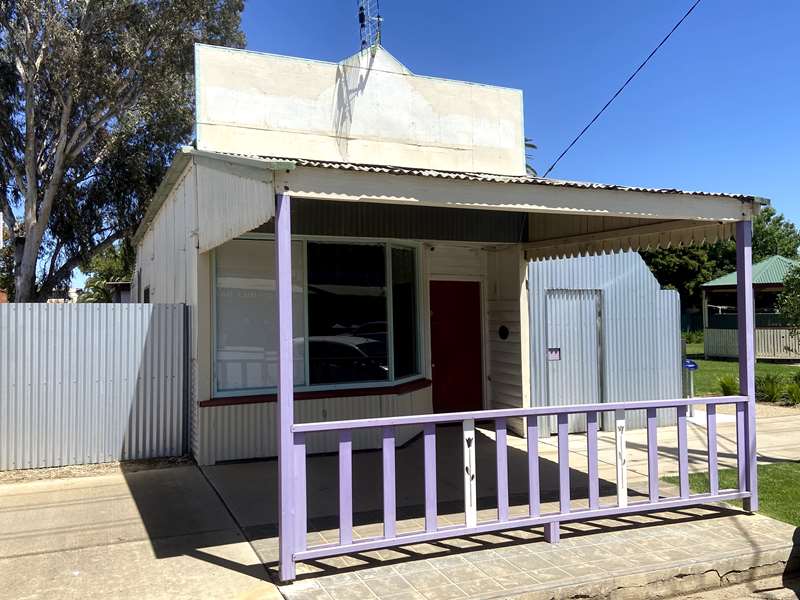
This building has seen many uses. Over the years it was used as a dentist's surgery, a bakery shop, a barber's shop, a frock shop, a residence, a solicitor's office and a gift shop.
5. 5 Kelly Street
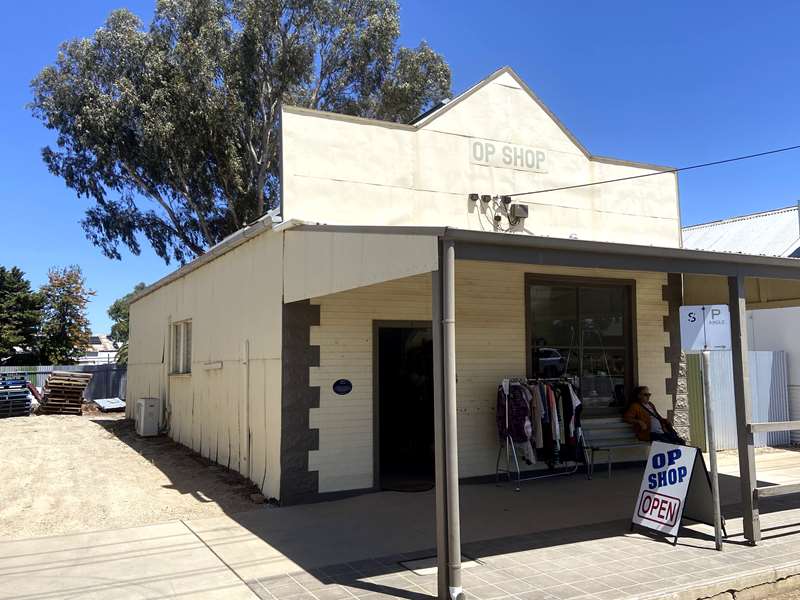
Built in the 1890s, and owned by John McKay from the general store across Kelly Street, this building was originally a plumber's shop. James Baker was the first plumber and tinsmith. The business and building were purchased by the Pyramid Co-Operative Society. Some of the plumbers to work here were P Lancaster, J Merrigan and G Miller. Later Kevin Weinert used the building as a carpentry workshop. Then, for many years, Cheryl Bartels conducted a fabric shop here. The building now operates as an Opportunity Shop serving the local community.
6. Finemore's Tea Rooms
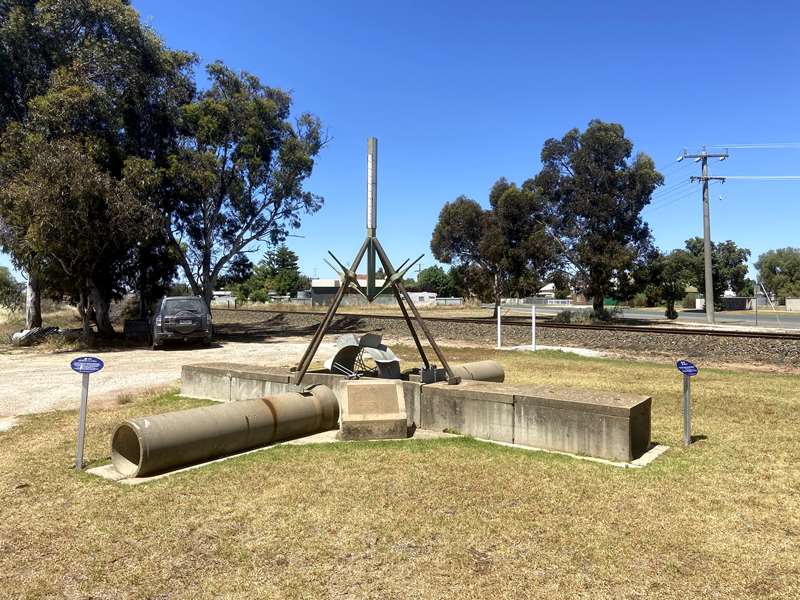
In the early 1900's Mrs J Finemore provided tea and dining rooms here. There was also a boarding house catering particularly for train travellers. She advertised "Afternoon tea, first class meals and special accommodation for travellers. Meals at all hours from 6 in the morning till after the night train"
In the early hours of 28th February, 1913, a fire broke out in a bedroom. "The fire was first noticed by Miss Herrick, their property being close to the establishment and she alarmed a good many people in the neigbourhood before the bell rang". The damage was not severe and business continued. The boarding house was again damaged in January, 1920, when fire engulfed the nearby shops of A T Lacy's boot emporium, Herrick Bros, butchers and N B Webster, jeweler and watchmaker.
7. National Bank
The first National Bank in the township was opened in 1884 at 43 Kelly Street next to Smith and Holland's General Store.
The first manager was R G Fincham. He was involved in starting the Agricultural Society which, in 1888, held the first Show. It "...was generally acclaimed the best in the north". Later in the 1880s the bank moved to a brick building at this site. In 1891 the building was extended. "A spacious and commodious bank chamber has been erected and the manager's private quarters increased". This was "...a very good indication that the district is advancing".
It was replaced by this building in 1959. The front of the building is designed to capture maximum light while blocking direct sunlight from the hot westerly sun. The National Bank branch closed in June, 2002.
8. Memorial Hall
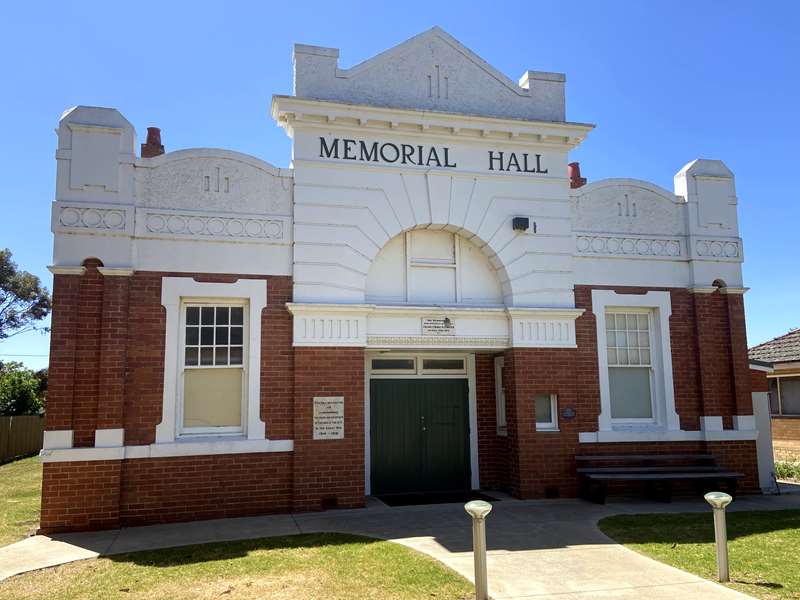
In 1878 William Bramley opened a store in Durham Ox. In March, 1888, he opened a drapery business on this site. A large number of hands were employed and a great volume of business was conducted.
"The place was bristling with dressmakers, including Miss McNeill, Messrs White and O'Brien, Miss Real, Misses Hynes and Killeen, Misses Lloyd and Halkridge and Mrs Herrick,"
On 23rd October, 1888, a fire started in the nearby residence of J H Kelly. It spread to Mr Bramley's new drapery store on the north side and Mr Phair's tobacconist and fancy goods shop on the south side. The National Bank brick building was saved. The Memorial Hall was opened in 1925.
9. 22 Kelly Street
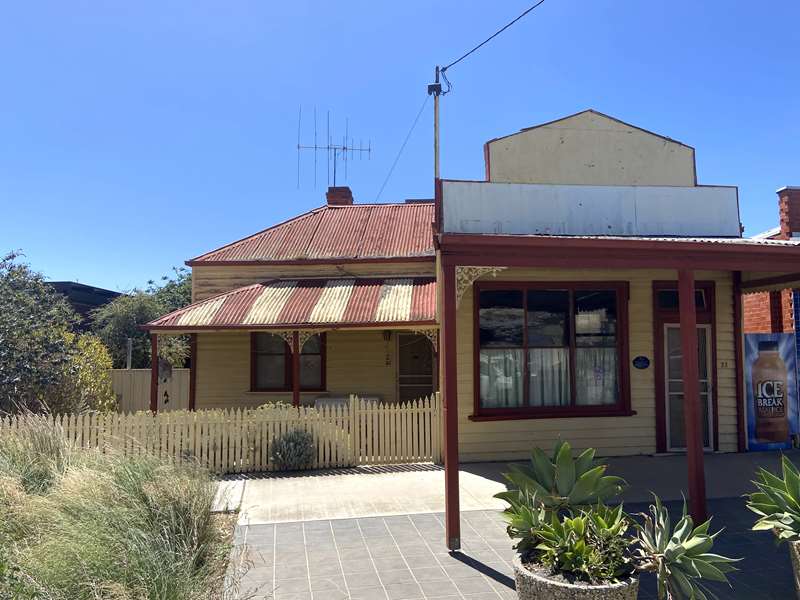
The railway line reached Pyramid in 1884. This building is one of the many that were brought into the township from Durham Ox, which immediately lost much of its importance.
The fruit shop business of W J Burrows was conducted here. B E Curnick then followed with his saddlery and harness business. N G Perritt was next to occupy the site with his hardware shop. The building then served as a ladies hairdressing salon. Among the hairdressers were Una Farrar, Doreen O'Brien, Ray Mansfield, Noelene Ralphs and Bettina Hawken. From the early 1960s Mr and Mrs J Butterworth occupied the attached residence. ANA - Australian Natives Association (which became Australian Unity in 1993) operated an Agency here from 1981 until 2001. The Neighbourhood House was also here for some years.
10. Cafe
The owner of the adjoining newsagency, J Glass, originally built a billiards saloon and two offices on this site. In 1935, Mr Glass remodelled the building, with the billiards saloon being converted into a cafe. J Bonica advised that he was commencing business under the trade name of Lamaro's Cafe. He announced that "...with elaborate internal fittings the cafe is up to date in every respect and equal to anything of the kind in the North". In 1937 a dentist, F Finigan, used one office and a barber, R Russell, used the other office. Since Bonica's a number of cafe businesses have operated here. In 2001 the building was destroyed by fire and replaced by this current building.
11. Newsagency
J Brown, book seller and stationer, opened a shop on this site in 1888. After a fire in 1889 the shop was rebuilt.
A Westrup, W Whittle, H Butler and C Watson followed as newsagents. J Glass purchased the business in 1917.
As well as being newsagent, stationer, tobacconist and fancy goods trader, Mr Glass conducted an agency for B Edwards, watch maker and jeweller. He also established an adjoining billiards saloon, where tournaments were often held, and two offices. William Wallace & Co conducted a Stock and Land business in one office.
In 1935 J Glass disposed of the business to R G Jones. He sold the business in 1947 and a number of newsagents have since followed. In 2001 the building was destroyed by fire and replaced by this current building.
12. Store
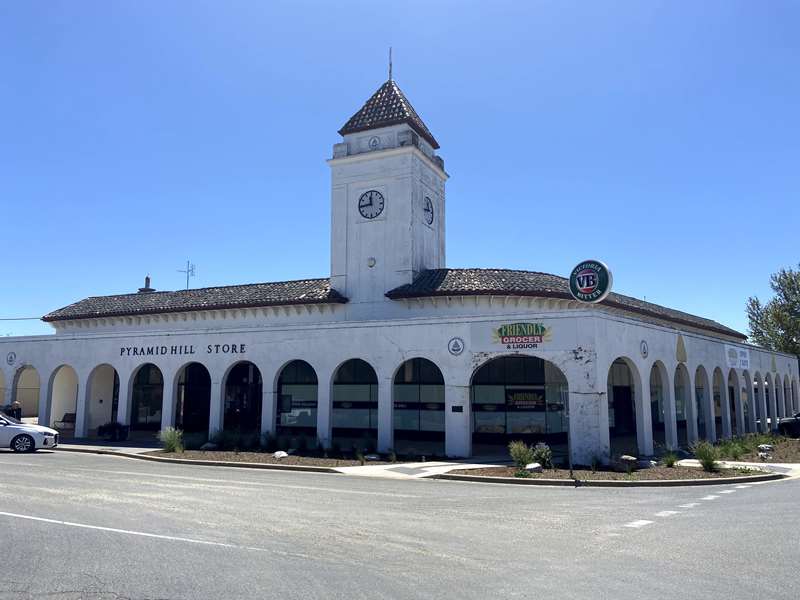
John McKay opened a general store on this site in 1885. In 1919 he sold the expanded department store to the newly formed Pyramid Co-operative Society Ltd. The store burnt to the ground in 1932 and this new building arose in 1933. It is designed in the then fashionable Mediterranean style with shady verandahs beneath the arches and expansive display windows. The clock tower has become a prominent feature of the town.
The Pyramid Co-operative Society proved to be a mainstay of the local economy. Under the management of A R (Dick) Appleby it went on to amalgamate with the Pyramid Butter Factory in 1945, and to purchase the Mincha Butter Factory in 1949. After a number of amalgamations the store passed from Murray Goulbourn Co-operative Co Limited into private ownership in 1988.
13. Pyramid Hill Advertiser
In May, 1889, Samuel Seales published the first edition of the Pyramid Hill Advertiser on this site. The paper was published every Friday morning for a price of 3 shillings and 6 pence per quarter. In March, 1890, ownership passed to S G Seales. He was succeeded by H A Seales. The paper was published by A J Williams from 1929 until 1945. He was awarded the MBE for his services to country journalism. R E McRostie began publishing the paper in 1946 and he was succeeded by N McRostie. The last edition of the Advertiser was published on Jan 13, 1971.
14. Doctor's Residence
For many years this site was the residence of the township's doctors. Dr Ross was the first doctor in 1887. Doctors to follow were:
1888 - Deravin, 1893 - Kelly, 1897 - Peipers, 1898 - Bill, 1905 - Woodside, 1909 - Ridley, 1911 - Merrillees, 1912 - Jacobs, 1916 - Prichard, 1921 - Oakley, 1923 - Triado, 1925 - Hands, 1933 - Steele, 1937 - Brunskill, 1939 - Harlem, 1946 - Retallick and 1955 - Jackson. The house is now a private residence.
15. Bakery
In 1884 W Neale Jnr established a bakery here. He was followed by W Neale Snr in 1890, John McKay in 1900, Charles Watson in 1904 and S Mayberry in 1926. H (Pop) Elliott, accompanied by Gordon Lucas, moved from Penshurst to take over the bakery in 1927. After becoming partners with Pop Elliott in 1936, Gordon bought the bakery in 1947. In the 1950s he was a familiar sight with his bread cart and horse, Tommy. As Gordon walked delivering bread Tommy would continue on and wait a few houses ahead. On Sunday evenings townsfolk would line up to buy bread fresh from the oven. From 1967 the bakers to follow were Jack Findlay, Don McDermid, Mark Allen, Graham Ballis and Neil Fraser. Northern District Community Health established their services in the building in 1999.
16. State Rivers Office
The provision of a reliable water supply to this area commenced with the establishment of the Tragowel Plains Irrigation and Water Supply Trust in 1886. On 2nd July, 1886, Sir Henry Broughan Loch, Governor of Victoria, turned the first sod of the irrigation channels to the west of the town. The construction of the channels was a significant development for the land holders on the surrounding plains.
In 1906 tenders were invited for the construction of a two-roomed brick office here by the State Rivers and Water Supply Commission. The construction of this building in 1907, and extension in 1922, reflected the importance of Pyramid Hill's role in administering the irrigation district eventually covering some 500,000 acres. The Commission moved into new office, workshop and store yard facilities in Barber Street in March, 1966.
17. 16 Victoria Street
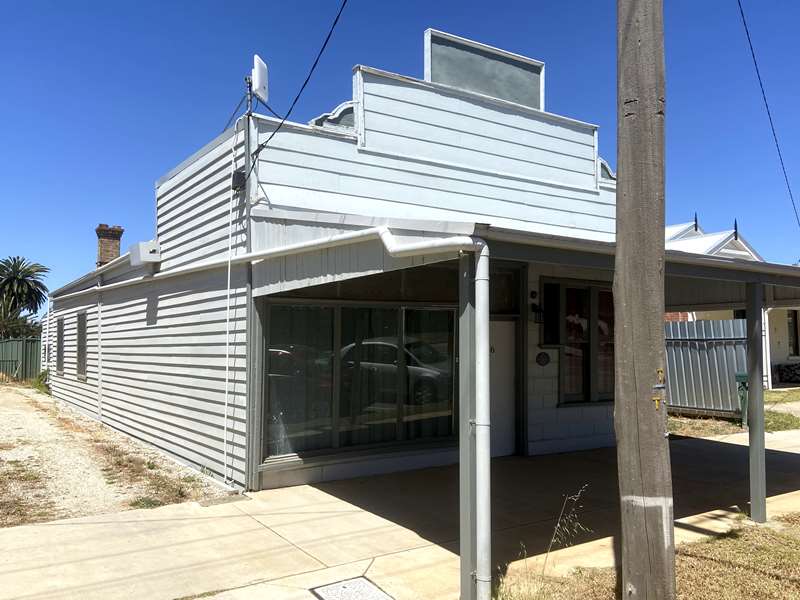
In the early 1880s the Colonial Bank was situated in this building with Mr Sprott as manager. The bank closed in August, 1894. In 1924 Mrs E M Ault took over the Pyramid Tea Rooms, previously carried as on here by Mrs M Watson.
In the early hours of 22nd March, 1929, a "wandering bull" saw his reflection in the plate-glass window of the refreshment rooms. Thinking he had encountered a rival, the neighbourhood was disturbed by the sound of falling glass as the beast attacked the shopfront.
Mr S A Gant visited weekly from Bendigo to conduct a dental practice from attached rooms. W Crichton, then J Townsend, followed by Mrs S Townsend, operated an electrical business here. In 1971 I G and H M Bartels commenced their electrical business until 1987 when they relocated to McKay Street.
18. Victoria Hotel
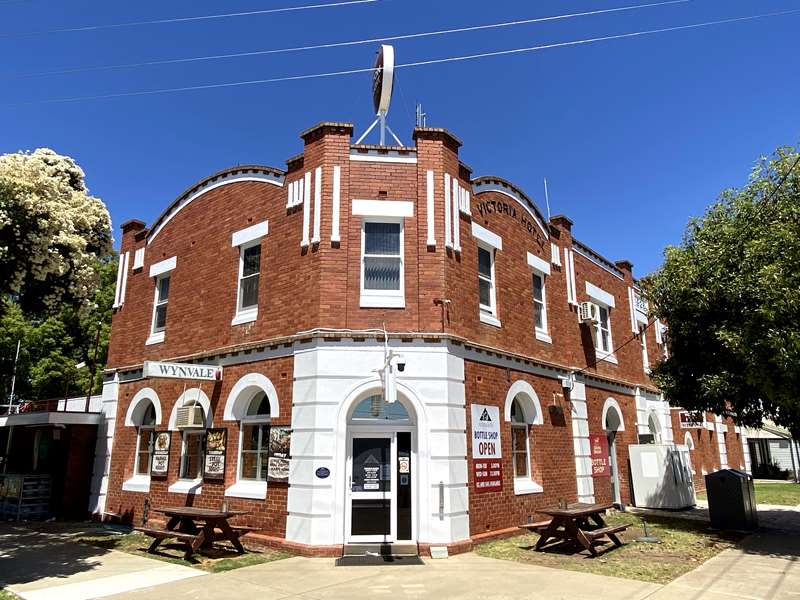
In 1884 Thomas Watson, owner of a store and hotel at the early settlement of Mt Pyramid at the hill, established the Victoria Hotel and Hall at this site. The hall was used for social events and by several congregations for services before the building of churches. The Victoria Hotel and Hall were burnt down in 1926. The current red brick building was erected in 1928. The Kelly family were publicans here for a long period. Martin Kelly became licensee in 1907 until his death in 1916. His wife Bridget and then their children Thomas, Margaret, Teresa and Vincent Kelly ran the hotel until 1951. In the late 1950s eight locals pitched in 500 pounds each to loan champion VFL player and popular local football coach, Bill "Motet Williams, the money to buy the lease.
19. Butcher Shop
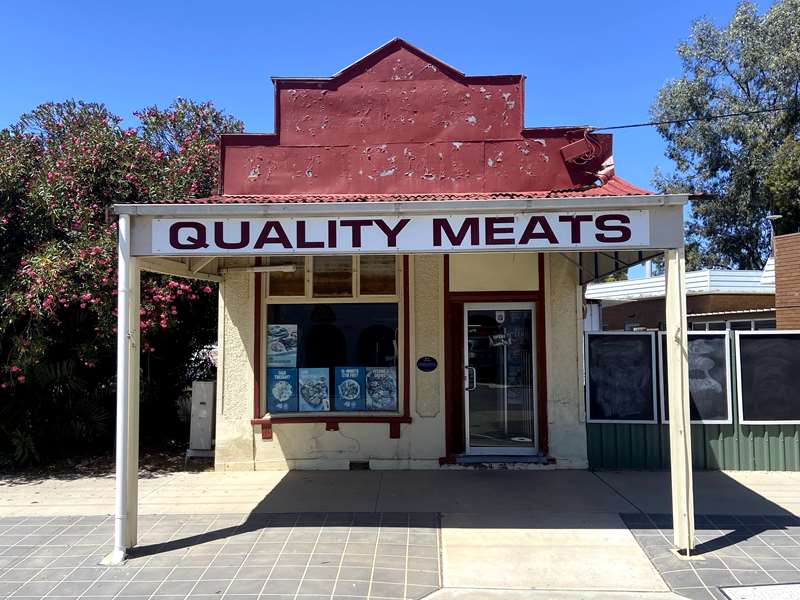
Francis Todd was the first butcher on this site in the early 1890s. In 1901, William Herrick, one of the first selectors of the district, took over the business. He was succeeded by his sons, William, Edward and Ambrose, in 1908. On 2nd January, 1920, the building was seriously damaged by fire. The Herrick brothers carried on their business at the nearby Gregory buildings while repairs were carried out. From 1952 butchers named Dark, Pryor, Amarant, Warren and Walters have continued to serve the community.
20. 32 Victoria Street
In the 1880's William Todd and William Leach conducted a drapery business on this site. "You could buy the latest fashion in hats at Todd and Leach's drapers shop for six shillings". In later years Bennett's drapery store occupied the site. Jock Chalmers also had his boot repair business on the premises. The building was later demolished. When this new building arose in 1981, a frock shop and hairdressing salon was opened by Bettina Hawken.
21. Gregory's Shop and Undertaking
Robert (Bob) Gregory, cabinet maker and builder, purchased a horse-drawn hearse in 1886 and commenced his undertaking business. It was part of a broader general agency and store on this site. He also ran a grain buying business.
The first motorised funeral was held in 1929. Bob died in 1933 and the business was taken over by his son Robert (Bert) Augustus Gregory. The business name changed to R A Gregory & Sons. The Gregory store included hardware, farm machinery, drapery and fancy goods. International tractors and harvesters, refrigerators, Shell petrol, Vida mowers, Malvern Star bicycles and numerous other goods were sold. When Bert died in 1967 John Gregory took over the business. The funeral business was sold to A G Adams of Kerang in 1998 ending the oldest family business in Pyramid Hill.
22. Police Station
The first police station near the railway line at 41 Kelly Street. Constable Riley was the first resident policeman. In 1891 it was reported that "A new police station is to be constructed soon, the site having already been selected and the land purchased near the Post Office". Since 1884, almost 30 police members have been stationed at Pyramid Hill. The last mounted policeman was First Constable H W Birthisel who served from 1940 to 1949.
23. Post Office
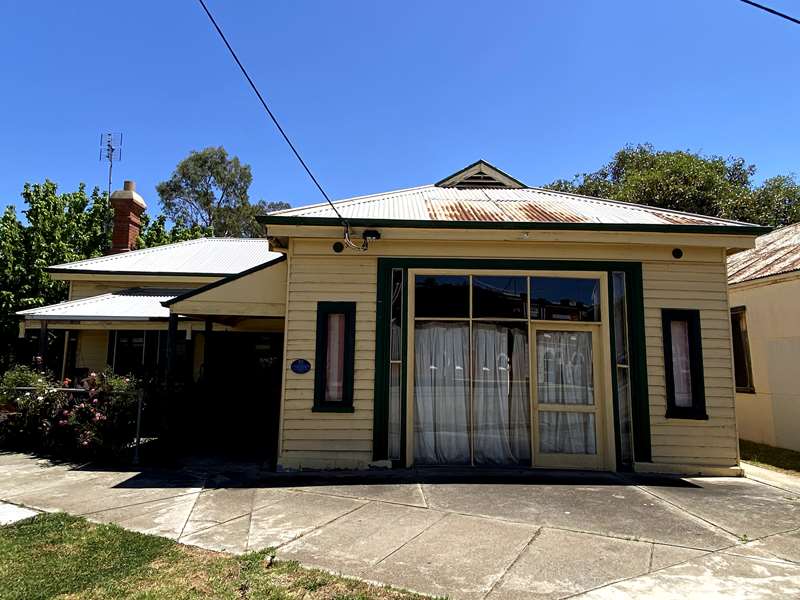
With the arrival of train services in 1884, the town's postal business was conducted at the railway station. The west side of this building was built in 1890 for a sum of 798 pounds. It was gazetted in 1891 as a Class 'C' Post Office. The first post mistress in charge was Miss Robertson. It was reported at the time that "The great convenience felt by having a building set apart for post and telegraph business only is highly appreciated". The eastern porch section was added in 1936.
Mail runs were conducted from here to deliver mail to the surrounding farming communities. The manual telephone exchange closed in 1982 when the telephone service became automatic. The old exchange switchboard can be viewed in the local historical museum. The Post Office was closed in 1999.
24. 17 Victoria Street
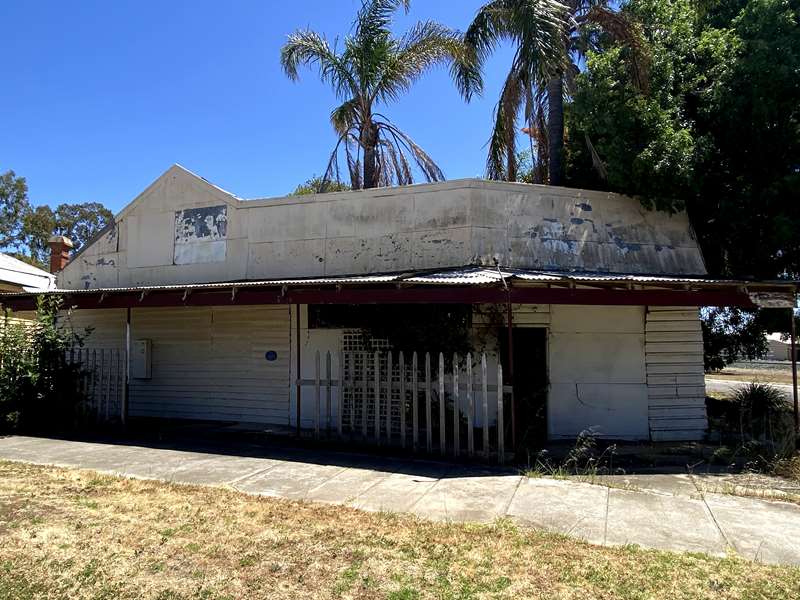
In the early 1900s J S Blow ran a cafe in this building. The cafe provided "...luscious fruits, vegetables, confectionery and tobacconist wares" and "...on a warm day a drink off the ice, or an ice cream for the children". There were also "...attentive waitresses ready to serve you afternoon tea". There was also accommodation and a "well appointed" billiard saloon. White Bros, jewellers had an agency in the cafe. Norman McIver took over in 1922. McIver's Hairdressing Saloon was opened on the west side of the building. In 1929 Mr G Perry became hair dresser and advised that "...shampoos and face massage are a specialty." Other hair dressers followed, with Jack Hare being the last. In 1949 Ted Wall took over the caf? followed by Alan Brooks and then Max Ladson.
25. John McKay Residence
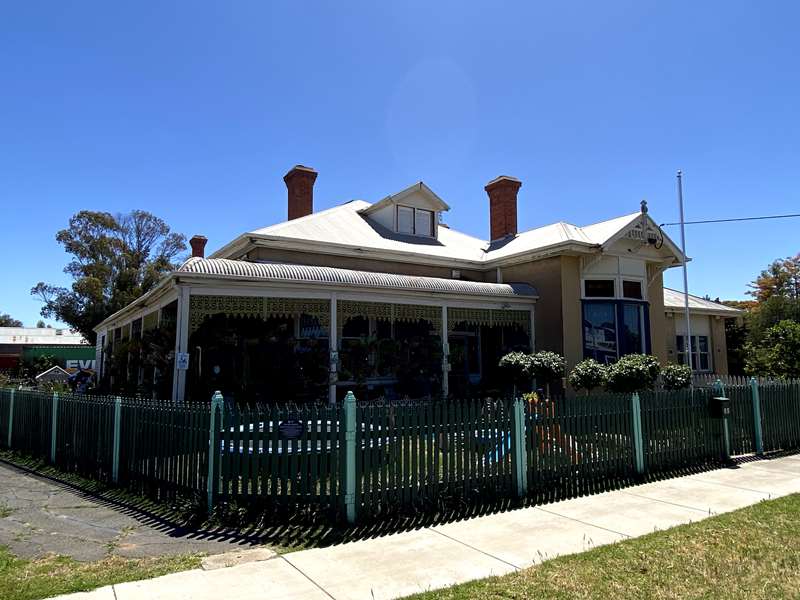
John McKay started his general store business on the corner of Victoria and Kelly Streets in 1885. He went on to purchase a number of businesses across the region. His brother, Hugh V McKay, was inventor of the "Sunshine" harvester and founder of Sunshine Harvester Works.
He built this residence and named it "Lumleah". In 1921 he advertised for sale "...his superior reinforced concrete residence containing 9 rooms, linen press, pantry, bathroom, attic, detached garage and wash house with copper built in. Hot and cold water laid on."
In 1922 Sister E Brown purchased the house and conducted Lumleah Private Hospital here for 10 years. From 1932 the residence served as the local Bush Nursing Hospital. Extensions were made in 1936. A new hospital opened in 1959 and this building is now a private residence.
26. Sale Yards
27. Charters Garage
28. Railway Station
29. Lacy's
The building on this site was known as Lacy's Boot Emporium. In 1913, after purchasing the previous boot business of Mr Chant, S G Lacy advised that "My aim is to turn out all work with neatness and promptness. Best of material and workmanship is guaranteed".
In 1935, S Kerr commenced business here as a florist and seedsman. He advised that "Orders will be taken for fruit and citrus trees, shrubs and roses, which are to be secured from the leading nurseries of the State. Seedlings of annuals will be stocked embracing the choicest varieties, and cut flowers will be a specialty". The RSAILA, later RSL, used the shop as a meeting room after WW2. It became a State Bank branch. Then F & R Catanese established a fruit shop. The shop was later demolished.
30. Pyramid Hill Coffee Palace
In the late 1880s the Pyramid Hill Coffee Palace on this site was the only two storey building in the township. The building of about 40 rooms provided refreshments and accommodation. It was owned by P Major and later by Mrs M Middleton. In 1890 Mrs Middleton obtained a Colonial Wine License to operate an adjoining wine shop.
In May, 1899, the building was destroyed by fire. In August, 1900, a public auction was held to sell the land and remaining buildings. They consisted of "...an 8 stall stable, coach house, building over cellar 24 by 12 ft, underground tank and other buildings".
31. Dudley Flats
A single storey rooming house next to the railway line was known as Dudley Flats. It consisted of a number of rooms facing onto a verandah with a kitchen at the back. In the 1950s it was often home to quarry workers recently emigrated from the Baltic countries in Europe.
The "Balts" all travelled to and from the quarry standing in the back of an old Army "Blitz" truck. The flats were later demolished and remnants may be seen as part of the shearing shed standing just over 2 kms south of Pyramid on the west side ofthe Bendigo road.
Photos:
Location
Kelly Street, Pyramid Hill 3575 Map









